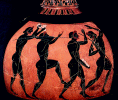Since no Greek wall painting has survived, vase painting is the only remaining example of Greek painting. Often the figures on the vases are mythical gods and heroes but scenes of daily life also appear. Although some of the earliest Greek pots probably had a funerary function as grave markers and perhaps as ritual objects (some had open tops for libations in honor of the dead), a wide variety of shapes developed, depending on the functions of the vessel. By the early 6th century BCE, both the potters and the painters were signing these vases.

| Early example of "geometric" pot.
This vase shows a desire for order, achieved through repetition of motifs. Remember that "chaos" is a word we inherited from the Greeks. A rigorous discipline in design is applied to the pot. |
 | Dipylon Vase (Attic geometric amphora)
about 750 BCE.
approximately 61" high
This large amphora marked a grave in a cemetery in Athens. The entire surface of the pot is covered with precisely painted geometric motifs. The "belly" of the pot, however, introduces human figures in a scene depicting the deceased on a bier and mourning figures on each side. The figures are represented as geometric shapes--the torsos as triangles to which legs, arms, and profile heads have been attached.
|
 | Orientalizing vase
about 620 BCE
During the seventh century Greek trade and colonization accelerated; thus Greek artists encountered Near Eastern and Egyptian works of art and came under new so-called "oriental" influences. Motifs like the sphinx and other fantastic creatures recur. Here the snake-haired Gorgons and mythical Medusa are depicted. Although the general trend in Greek art is toward greater realism, in this period of Greek art the emphasis is on fantastic, irrational elements. This is also the time period when Dionysiac mysteries were introduced in Greece; these represented a less rational form of religion.
|
 |
Exekias
Achilles and Ajax at Board Game
540-530 BCE
black-figure vase
The sixth century represents the high point of Greek vase painting. The vases are masterpieces of drawing and design within a restricted range of color--glossy black, the natural red of clay, and someimes added white or purple. Designs often fit the shape of vase. The technique of this vase is called "black-figure," with the careful detail made through incising the lines.
|
 
| Panathenaic trophy vases, front and back.
Greek pots were not only utilitarian objects but some were trophies given to winners in Olympic games--for events such as boxing, the penthathon, mule racing, and the like.
|